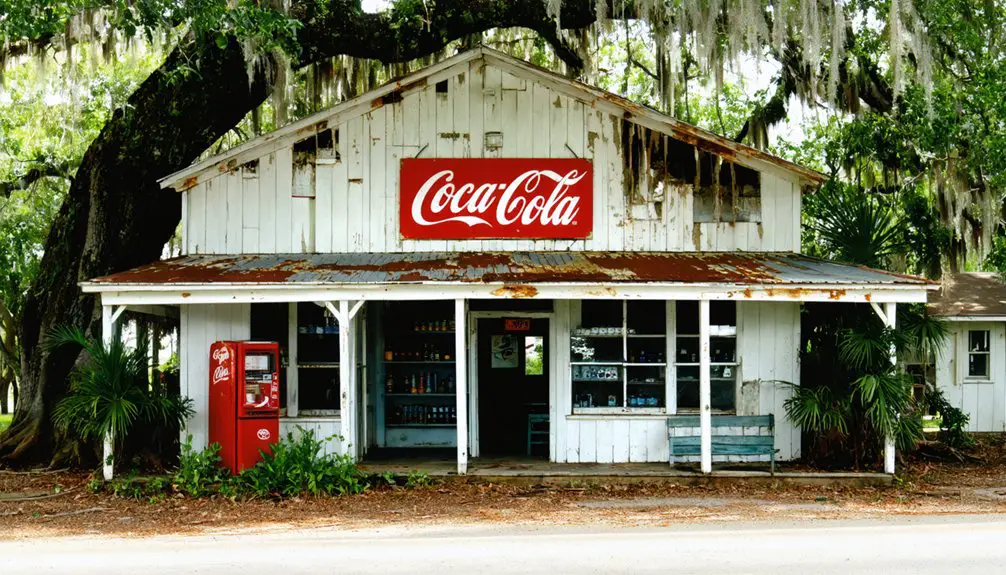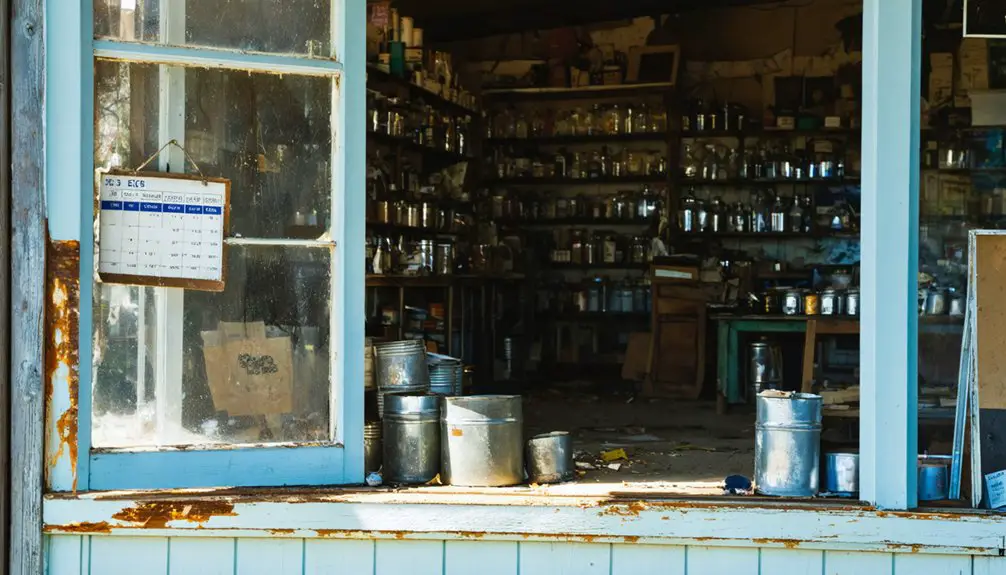You’ll find Indiantown challenges the typical ghost town narrative. Founded in 1924 as S. Davies Warfield’s ambitious railroad hub, this Florida community has transformed from a small trading post into a thriving population of 6,500 residents. While preserving landmarks like the historic Seminole Inn, Indiantown’s cultural landscape has evolved through Maya immigration since the 1980s, creating a unique blend of pioneer heritage and indigenous traditions. The town’s layered history reveals surprising connections between railroads, agriculture, and cultural preservation.
Key Takeaways
- Indiantown is not a ghost town but an active community with 6,560 residents as of 2020, featuring a thriving Maya population.
- The town survived the 1928 Okeechobee Hurricane and economic setbacks, maintaining continuous habitation since its early Seminole trading post origins.
- Despite railroad empire plans falling through, Indiantown adapted with new transportation infrastructure including docks and an airstrip in the 1950s.
- Historic landmarks like the Seminole Inn and Leach Mansion remain preserved and actively used, unlike typical ghost town structures.
- The community maintains economic viability through agriculture, particularly cattle ranching and citrus farming, supported by modern irrigation systems.
Early Indigenous Trading Post and Pioneer Settlement
While the Seminole people sought refuge from U.S. Army forces after the First Seminole War, they established a strategic trading post on elevated ground surrounded by rich hunting and fishing grounds. The location’s natural resources and protective swampland proved ideal for both survival and commerce.
You’ll find the trading dynamics centered around the exchange of animal hides and egret plumes for essential supplies like grits, flour, and cast iron goods. The post became a vibrant hub of cultural exchange where Seminole families would camp for days, their dugouts moored nearby. The development of Seaboard rail line in 1924 brought new economic opportunities to the settlement.
When white settlers arrived in the 1890s, Joe and Dessie Bowers developed citrus groves while maintaining the trading traditions. The Jupiter Indiantown Road’s construction in 1899 strengthened these commercial ties, though the 16-mile journey initially required two days by oxcart. Today, the area has grown into a diverse community with 48.93% Hispanic or Latino residents, reflecting its continued evolution as a cultural melting pot.
S. Davies Warfield’s Vision and the Seminole Inn Era
S. Davies Warfield’s ambitious vision for Indiantown centered on transforming this small Florida settlement into the southern headquarters of his Seaboard Air Line Railway empire through a 204-mile rail extension from Coleman to West Palm Beach.
You’ll find his grandest remaining legacy in the historic Seminole Inn, which he personally built as part of his planned model city and which still stands as a National Register landmark.
The Inn carries an intriguing royal connection through Warfield’s niece Wallis Warfield Simpson, who worked there before later becoming the Duchess of Windsor.
His vision for Indiantown’s growth came to an abrupt end with the devastating 1928 Okeechobee Hurricane that ravaged the region.
Railroad Empire Dreams
During the ambitious railroad expansion of 1924, banking mogul S. Davies Warfield extended the Seaboard Air Line Railway south through Indiantown to West Palm Beach.
His vision wasn’t just about laying tracks – he saw Indiantown as the future crown jewel of his railroad empire, a model city that would transform South Central Florida’s economic development.
- Construction of the iconic Seminole Inn, personally overseen by Warfield
- Development of paved streets, housing, and schools around a central railway station
- Strategic positioning as the southern hub of the Seaboard network
- Creation of essential transportation links connecting Florida’s key regions
You can still see traces of these grand plans in Indiantown today, though they were ultimately cut short by Warfield’s death in 1927 and the devastating combination of the Florida land bust and 1928 Okeechobee hurricane.
Historic Inn’s Royal Connections
Inside the historic Seminole Inn, built in 1926, you’ll find more than just Mission Revival architecture and pecky cypress ceilings – it’s a building steeped in royal connections and ambitious dreams.
S. Davies Warfield constructed this landmark during Florida’s land boom, envisioning it as the centerpiece of a thriving railway hub.
The inn’s royal legacy emerges through Warfield’s niece, Wallis Warfield Simpson, who frequently visited before becoming the Duchess of Windsor.
Bronze chandeliers bearing royal marks and distinctive interior features add to the historical allure. The winding staircases lead to a charming sitting room, capturing the essence of Old Florida elegance. Designed by architect Henry Stephen Harvey, the inn exemplifies the Spanish Colonial Revival style that was popular during the 1920s.
Listed on the National Register of Historic Places since 2006, the Seminole Inn stands as one of the few surviving landmarks from Florida’s railroad expansion era, offering you a glimpse into both local heritage and global history.
From Railroad Hub to Modern Transportation Center
When railroad magnate Davies Warfield extended the Seaboard Air Line Railroad through Indiantown in 1924, he envisioned creating South Florida’s premier transportation hub. His ambitious transportation evolution included a model city plan with paved streets, modern infrastructure, and the iconic Seminole Inn.
However, infrastructural challenges and economic setbacks derailed these dreams.
Grand visions and ambitious plans crumbled in the face of harsh realities and unexpected obstacles.
- The devastating 1928 Okeechobee hurricane severely damaged the growing community
- Warfield’s death in 1927 halted major expansion plans
- Passenger service ended in 1971 with Amtrak’s changeover
- The 1950s brought adaptation with new docks and a 6,000-foot airstrip
You’ll find that while Indiantown didn’t become the railroad empire Warfield imagined, it transformed through the decades, incorporating river transport and air travel to maintain its transportation legacy in a different form.
Maya Migration and Cultural Transformation
You’ll find Indiantown’s transformation deeply rooted in Maya migration patterns, as over 4,000 indigenous Maya people have settled here since the 1980s, fleeing persecution in Guatemala.
The Maya community has maintained strong cultural traditions while adapting to life in Florida, creating a vibrant presence through local advocacy groups and cultural celebrations. The town has become part of a larger trend, with Maya populations rising dramatically across Florida in recent years.
Your visit to modern Indiantown reveals a thriving Maya heritage, evident in everything from local businesses to community gatherings, marking a significant shift from the town’s railroad origins to its current identity as a multicultural hub. The town’s development was significantly influenced by the arrival of Kanjobal Maya workers in 1982 for agricultural labor.
Indigenous Identity and Community
Throughout the early 1980s, Maya migration to Indiantown, Florida marked a significant transformation in the region’s indigenous identity, as thousands fled Guatemala’s devastating civil war and “scorched earth” campaigns.
You’ll find their resilient community has grown from 4,000 to potentially 50,000 members, establishing deep roots while maintaining their cultural heritage. The area’s history of Maya presence dates back centuries, as Itsate-speaking Seminoles identified themselves as Mayas in the early 1900s.
Their commitment to community cohesion manifests through:
- Social and ethnic organizations that preserve traditions and provide mutual support
- Cultural events and celebrations mirroring those in Guatemala
- Transnational networks connecting Florida communities with indigenous hometowns
- Community leaders working as advocates to aid Maya adaptation
These networks have transformed Indiantown from a temporary settlement into a thriving multi-generational community, where indigenous identity flourishes despite legal and economic challenges. Many Maya immigrants speak one of twenty languages and continue their traditional practices while adapting to life in Florida.
Maya Cultural Heritage Today
Despite relocating far from their ancestral lands, Maya migrants in Indiantown have preserved their rich cultural heritage while adapting to new American contexts.
You’ll find Maya traditions thriving through ceremonial gatherings, craft production, and language preservation, showcasing remarkable cultural resilience in the face of change.
In homes throughout Indiantown, Maya artisans continue their ancestral craftsmanship, working with materials like freshwater mussel shells for jewelry and ceremonial pieces. Just as their ancestors did, they maintain elite craft production within their own households.
They’ve maintained traditional gender roles in craft production while creating new economic opportunities.
Community events serve as essential spaces where elders pass down oral histories and traditional ecological knowledge to younger generations.
Through museums and cultural centers, they’re actively preserving their heritage while educating others about their living culture’s significance in contemporary America.
Population Growth Since 1980s
The 1980s marked a defining era for Indiantown as Maya refugees from Guatemala began arriving, fundamentally reshaping the town’s demographic landscape. The population dynamics shifted dramatically through rural migration patterns, transforming this small Florida community into a vibrant multicultural hub.
You’ll find these key developments in Indiantown’s growth:
- Population increased to 6,560 by 2020, with Maya residents comprising a significant portion
- The community maintains a young median age of 30.5 years, reflecting its working-age population
- Ethnic diversity expanded, with Hispanic categories now representing over 57% of residents
- Transportation infrastructure and agricultural opportunities continue drawing new residents
This growth pattern reflects broader Florida trends, where net migration drove 86.8% of population increases during the 1980s, establishing Indiantown’s unique cultural identity.
Economic Cycles: Boom, Bust, and Agricultural Revival
Since its early development in the 1920s, Indiantown’s economy has followed distinct cycles of growth and decline, marked by Baltimore banker Davies Warfield’s ambitious vision to establish a Seaboard Airline Railroad headquarters.
While the railroad project didn’t meet all expectations, you’ll find that economic fluctuations didn’t stop the town’s resilience.
Agriculture became Indiantown’s backbone, with cattle ranching and citrus farming leading the way until the 1960s.
When King Ranch arrived, they transformed the landscape by converting cattle land into intensive farming operations.
Despite challenges from agricultural policies, pest outbreaks, and market competition, the community adapted.
Modern irrigation systems, improved farming techniques, and the growth of agribusiness infrastructure have sustained Indiantown’s agricultural revival, supporting a steady population that’s reached 6,668 residents by 2022.
Historical Landmarks and Preserved Heritage

While many Florida ghost towns fade into obscurity, Indiantown’s rich architectural heritage remains alive through carefully preserved landmarks like the stately Leach Mansion and Indian Key Historic State Park.
Unlike abandoned Florida settlements, Indiantown stands proudly with its preserved architectural treasures, keeping the region’s storied past vibrantly alive.
You’ll discover a community deeply committed to heritage conservation, where wooden structures tell stories of pioneer life and cultural resilience.
Key preserved elements include:
- The Leach Mansion (Tuckahoe), showcasing early 20th-century architectural significance
- Indian Key’s hand-made street signs and original settlement grid
- Maya cultural centers preserving indigenous languages and traditions
- Historical markers documenting agricultural and transportation evolution
Despite preservation challenges, Indiantown’s landmarks serve as living classrooms where you can explore the intersection of Native American, pioneer, and immigrant histories through guided tours and cultural festivals.
Frequently Asked Questions
What Happened to the Original Seminole Population After White Settlers Arrived?
You’ll find the Seminoles faced cultural assimilation and displacement, with most being forced to Oklahoma between 1832-1842. Only about 350-575 remained in Florida, retreating to the Everglades for survival.
How Did Local Wildlife and Ecosystems Change as Indiantown Developed?
You’d have seen massive ecosystem disruption as wetlands were drained and native habitats cleared for railroads and farms, forcing wildlife adaptation or displacement from their original hunting and nesting grounds.
What Traditional Maya Customs Are Still Practiced in Modern Indiantown?
You’ll find Maya rituals like traditional language classes, spiritual ceremonies, agricultural practices, and cultural celebrations continuing through community gatherings, shared meals, storytelling sessions, and religious syncretism with Catholic customs.
Were There Any Significant Natural Disasters That Affected Indiantown’s Development?
Like a watery siege, the 1928 Okeechobee hurricane’s impact changed your region forever, with flood damage crippling nearby towns. You’ve since weathered 77 hurricanes, including a major 1947 storm.
How Many Original Buildings From the 1800S Still Exist Today?
You won’t find any original buildings from the 1800s in today’s landscape, despite historic preservation efforts. The 1928 hurricane destroyed early structures, leaving only architectural significance from the early 1900s onward.
References
- https://floridanature.wordpress.com/2008/10/19/hunting-for-a-ghost-town-in-the-forest/
- https://www.ghosttowns.com/states/fl/indiantown.html
- https://www.journaloffloridastudies.org/0102ghosttowns.html
- https://floridatrailblazer.com/category/ghost-towns/page/2/
- https://en.wikipedia.org/wiki/Indiantown
- https://indiantownrealty.com/indiantown-community/
- https://electtonyz.com/2020/06/10/itown-history/
- https://floridaseminoletourism.com/seminole-spaces-trading-posts/
- https://stars.library.ucf.edu/cgi/viewcontent.cgi?article=3284&context=fhq
- https://www.florida-backroads-travel.com/indiantown-florida.html



